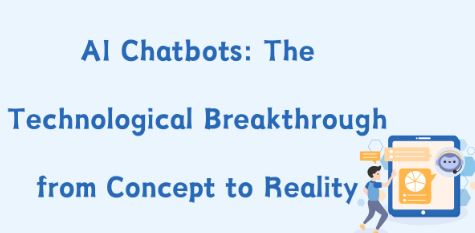AI Chatbots: The Technological Breakthrough from Concept to Reality
Introduction
In the last decade, the rise of artificial intelligence (AI) has transformed industries worldwide, but few innovations have captured as much attention as AI chatbots. These virtual assistants have evolved from simple rule-based systems to highly intelligent conversational agents capable of human-like interactions. With the rapid adoption of AI chatbots across various sectors, they are no longer seen as a futuristic concept but a technological reality that is reshaping the way businesses engage with their customers. This article delves into the evolution of AI chatbots, their underlying technologies, and their broad impact across industries.
What Is AI Chatbot?
AI chatbot is an advanced software program designed to simulate conversations with human users through text or voice interfaces. These chatbots leverage natural language processing (NLP), machine learning, and data analytics to understand and respond to user queries. Unlike traditional chatbots that relied on pre-programmed responses, modern AI chatbots can learn from user interactions and adapt over time, providing increasingly personalized experiences. In essence, they bridge the gap between human communication and artificial intelligence, creating a seamless interaction for users. A notable example of AI’s expansion into more niche applications is AI Waifu, a platform designed to create personalized, emotionally engaging virtual companions, showcasing just how versatile AI chatbots have become.
How Do AI Chatbots Work?
AI chatbots operate through a combination of algorithms, data processing, and machine learning. While they may seem simple from a user’s perspective, their functionality is driven by complex systems that process vast amounts of data in real-time.
Natural Language Processing (NLP)
At the heart of AI chatbot functionality is NLP, which enables machines to understand and interpret human language. Through NLP, chatbots can parse user input, identify key elements like intent and sentiment, and generate appropriate responses. NLP relies on vast linguistic databases and sophisticated algorithms to ensure that even nuanced or ambiguous queries are understood.
Machine Learning (ML)
Machine learning is what allows AI chatbots to improve their performance over time. By analyzing past conversations and interactions, chatbots can learn patterns, adapt their responses, and better predict user needs. ML helps chatbots become more intuitive and proactive, reducing the need for explicit user commands.
Contextual Understanding
Another critical component is contextual understanding, which allows chatbots to maintain conversation continuity. AI chatbots do not respond in isolation; instead, they recognize context, enabling more natural and flowing interactions. Whether a conversation spans multiple exchanges or even different user sessions, chatbots can retain relevant information, creating a personalized experience for each user.
Key Technologies Behind AI Chatbots
Behind every AI chatbot are foundational technologies that drive their intelligence and functionality. Understanding these key elements is crucial to appreciating how chatbots operate so seamlessly in real-world applications.
Natural Language Processing (NLP)
NLP enables chatbots to comprehend and process human language. By using tokenization, named entity recognition, and sentiment analysis, NLP breaks down complex linguistic input and allows chatbots to respond accurately. NLP ensures chatbots can handle diverse inputs, including slang, abbreviations, and different dialects.
Machine Learning Algorithms
Machine learning, particularly deep learning, forms the core of chatbot learning capabilities. Algorithms analyze large datasets to identify patterns, allowing chatbots to make predictions and offer relevant solutions based on previous interactions. This learning process ensures continuous improvement in bot performance.
Conversational AI Frameworks
These frameworks offer pre-built components that facilitate chatbot development. Popular frameworks like Google Dialogflow and Microsoft Bot Framework provide the necessary infrastructure for integrating NLP, ML, and speech recognition into chatbot platforms. They help streamline development while offering scalability.
Cloud Computing
Cloud-based infrastructures provide the computational power necessary for processing vast amounts of data in real time. With the support of cloud computing, AI chatbots can manage multiple simultaneous conversations, ensuring high efficiency and low latency in customer interactions.
Benefits of Using AI Chatbots
AI chatbots offer numerous advantages to businesses, enhancing both operational efficiency and customer experience. These benefits stem from the automation and personalization that AI enables, revolutionizing traditional customer service methods.
- 24/7 Availability: Unlike human agents, AI chatbots can operate round the clock, providing instant responses to customer queries regardless of the time zone or location.
- Cost Efficiency: By automating repetitive tasks, chatbots help businesses reduce labor costs and allocate resources more efficiently.
- Improved Customer Satisfaction: AI chatbots provide quick, accurate responses, reducing wait times and enhancing user experience. With personalized interactions, customers feel more valued.
- Scalability: Chatbots can handle multiple customer interactions simultaneously, making them highly scalable solutions for businesses of all sizes.
These factors contribute to the growing popularity of AI chatbots in customer-facing industries, providing both short-term gains and long-term strategic benefits.
How Are AI Chatbots Used in Different Industries?
AI chatbots have proven to be highly versatile, finding applications across a wide range of industries. They cater to different business needs, enhancing communication, customer support, and even sales.
E-commerce
In the e-commerce industry, AI chatbots are frequently used to assist customers in finding products, providing recommendations, and answering inquiries related to purchases. Chatbots also help with post-purchase support, like tracking orders or initiating returns. This streamlines the customer journey, making it more seamless and convenient for users.
Healthcare
AI chatbots in healthcare act as virtual assistants, helping patients schedule appointments, access medical information, and even perform basic diagnostics based on symptoms. With the ability to provide timely, reliable information, these chatbots enhance patient engagement and reduce the workload on healthcare professionals.
Banking and Finance
In banking, chatbots facilitate a wide range of services, including answering FAQs, processing transactions, and assisting customers with account-related inquiries. They also offer personalized financial advice by analyzing user data and financial behavior, helping individuals make more informed decisions.
Travel and Hospitality
For the travel and hospitality industries, AI chatbots handle customer reservations, provide travel recommendations, and assist with itinerary planning. They offer a more personalized travel experience while reducing manual workloads for service providers.
What Challenges Do AI Chatbots Face Currently?
Despite their numerous advantages, AI chatbots are not without their challenges. These obstacles primarily revolve around limitations in technology, data handling, and customer trust.
- Language and Cultural Barriers: AI chatbots often struggle to comprehend and adapt to multiple languages, dialects, and cultural nuances. This can lead to misunderstandings and errors in communication.
- Data Privacy Concerns: With chatbots accessing sensitive customer data, privacy and security become critical issues. Ensuring that user information is handled with utmost care is a significant challenge.
- Complex Query Handling: While AI chatbots are efficient with routine tasks, they may face difficulties in managing complex or highly specific inquiries that require deeper contextual understanding.
- Human-Like Interaction: Achieving a natural, human-like conversation remains a challenge. While AI chatbots are advancing, there is still a gap between machine-generated responses and human empathy and intuition.
Conclusion
The journey of AI chatbots from a conceptual technology to a transformative tool has been marked by significant advancements in machine learning, NLP, and data processing. As they continue to evolve, AI chatbots are poised to further revolutionize industries by streamlining processes and enhancing customer experiences. However, addressing current challenges such as data privacy and language limitations is crucial to fully realizing their potential. The future of AI chatbots promises even deeper integration into our daily lives, as they bridge the gap between human and machine interactions.



